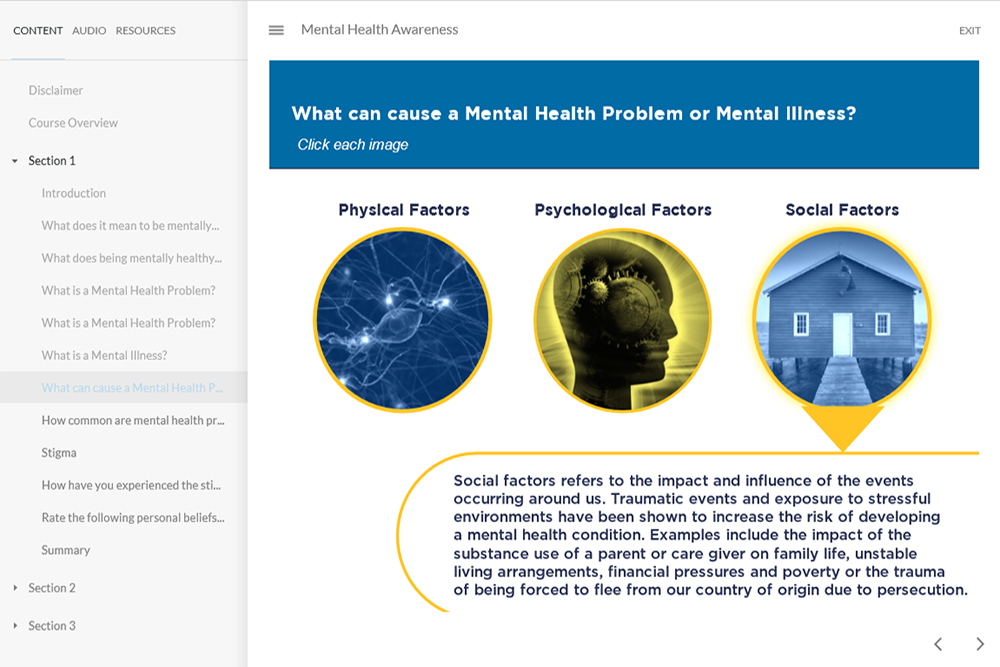
In collaboration with the Australian Medical Association, Western Australia, we designed and developed a dynamic eLearning course to improve the understanding of mental health in the workplace. Here’s a snapshot of the project.
What was the project?
The Australian Medical Association, Western Australia (AMAWA) tasked us with designing and developing eLearning modules to tackle misconceptions about mental health. The modules help learners understand and acknowledge mental health problems in the workplace and form part of AMAWA’s Mental Health Awareness course which is included in their wider workplace mental health program. Called On-Site/Insight the program provides employers with the training, resources, and expertise needed to launch a prevention-focused mental health strategy in their organisation.
How did we help?
We created several eLearning modules that blended interactive design elements, including engaging multimedia and a thought-provoking quiz format, to not only impart essential knowledge but also actively challenge and reshape learners’ perceptions about mental health in the workplace.
When creating the modules, it was important to be aware of design pitfalls – it can be easy to select stereotypical and extreme design elements when representing mental health conditions or emotions e.g. using dark colours and blank expression-less characters to illustrate a negative or ominous tone, while overly bright colours and comic-style characters might oversimplify a happy tone. Given the course aimed to dispel misconceptions and dismantle stigmas surrounding mental health, adopting a visual style that reinforced these very misconceptions would have been counterproductive.
We settled on a visual design that was simple and elegant, while consciously using elements that were more neutral in tone.
In addition to the visual design, another feature we used to help break down mental health pre-conceptions was a quiz. Learners were quizzed at the start of the course, with questions covering all areas of mental health but with a particular focus on topics where statistical facts and public perception diverge.
During the quiz, the learner isn’t given any immediate feedback to confirm or challenge their beliefs. But the responses, thanks to Storyline, are recorded.
When the learner completes the quiz, they are given some high-level feedback which is broken down as follows (but they don’t see their exact score):
- Scores 0 – 4 indicates that your mental health awareness will be significantly improved by the end of this course.
- Scores 5 – 7 indicates that while your mental health awareness is good it will be improved by doing this course.
- Scores 8 – 10 indicates your mental health awareness is above average and that this course will help fill in a few gaps.
Following this general feedback, the learner can access the main part of the course which takes them through different topics (touched on in the quiz) giving them more details and facts in a clear and concise manner while also using media elements such as video case studies and interactivity to bring the content to life.
But the quiz really comes into its own at the end of the course. At this point, the learner is given their scores from the first attempt and if it’s less than 100% they are asked to go back to review their responses and to change them based on what they’ve just learnt.
This second go at the quiz allows the learner to directly review feedback and critically think about why an answer is correct. It also keeps the learner in the quiz until all answers are correct.
This quiz format is effective as it softly introduces the learner to the course’s focus areas upfront with some high-level feedback on their initial perceptions. But at the end, the quiz more directly outlines areas where the learner was incorrect, empowering them to adjust their answers and reaffirm their new understanding of the facts.
In addition, Articulate Storyline allows for both quiz results (the initial and final result) to be shared with the Learning Management System (LMS) that’s hosting the course. This confirms completion but more importantly it allows AMAWA to report on the initial incorrect responses, providing more data on mental health perceptions which can help with course revisions and additional targeted training.
What were the results?
The project is an excellent example of eLearning design and function working together to tackle a very important subject such as mental health. Through thoughtful design and an interactive quiz format, the eLearning modules helped to dispel stereotypes and actively engaged learners in reshaping their perspectives. Articulate Storyline’s dual-functionality not only confirms completion but also provides crucial insights for continuous improvement.
If you have any questions or want more information, please get in touch.
